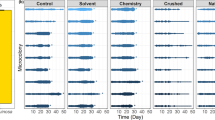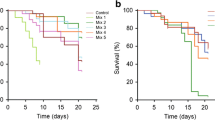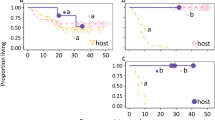Abstract
The high pollen and nectar yield of Asteraceae flowers combined with the abundance and diversity of these plants should make them an important pollen source for both specialist and generalist bees. However, studies have found Asteraceae pollen to be a poor diet for some generalist bees, possibly owing to nutrient deficiencies or the presence of secondary metabolites or digestive barriers that prevent nutrient assimilation. Mixing pollens could allow bees to exploit these unfavourable pollens, if the different pollen sources help to complement nutrient deficiencies or alleviate the effects of toxic secondary metabolites. In our study, we examined how the proportion of sunflower (Helianthus annuus, Asteraceae) pollen in the diet of captive-reared bumblebees (Bombus impatiens) affects the survival of bees in queenless microcolonies. Bees fed on sunflower pollen had significantly shorter lifespans than bees fed on broad bean (Vicia faba, Fabaceae), rapeseed (Brassica napus, Brassicaceae) or Cucurbitaceae pollen. However, survival on mixed pollen diets containing 50% sunflower pollen was as great as that on non-sunflower diets, which suggests that the other pollens were able to compensate for the low nutritive quality of the sunflower pollen. Due to agricultural intensification and a loss of wildflowers, farmland monocultures (e.g. sunflower crops) can be important floral resources for bumblebees. Our study suggests that providing alternative floral resources of high nutritive quality could help mitigate the potential harmful effects of a monofloral sunflower diet on bumblebees.




Similar content being viewed by others
References
Arnold SEJ, Idrovo MEP, Arias LJL, Belmain SR, Stevenson PC (2014) Herbivore defence compounds occur in pollen and reduce bumblebee colony fitness. J Chem Ecol 40:878–881. https://doi.org/10.1007/s10886-014-0467-4
Auclair JL, Jamieson CA (1948) A qualitative analysis of amino acids in pollen collected by bees. Science 108:357–358. https://doi.org/10.1126/science.108.2805.357
Baloglu GH, Gurel F (2015) The effects of pollen protein content on colony development of the bumblebee, Bombus terrestris L. J Api Sci 59:83–88. https://doi.org/10.1515/jas-2015-0009
Bidlingmeyer BA, Cohen SA, Tarvin TS (1984) Rapid analysis of amino acids using pre-column derivatization. J Chromatogr 336:93–104
Cnaani J, Schmid-Hempel R, Schmidt JO (2002) Colony development, larval development and worker reproduction in Bombus impatiens Cresson. Insectes Soc 49:164–170
Cnaani J, Wong A, Thomson JD (2007) Effect of group size on ovarian development in bumblebee workers (Hymenoptera: Apidae: Bombus). Entomol Gener 29:305–314
Cohen SA, Strydom DJ (1988) Amino acid analysis utilizing phenylisothiocyanate derivatives. Anal Biochem 174:1–16
De Groot AP (1953) Protein and amino acid requirements of the honey bee. Physiol Comp Oecol 3:197–285
Eckhardt M, Haider M, Dorn S, Müller A (2014) Pollen mixing in pollen generalist solitary bees: a possible strategy to complement or mitigate unfavourable pollen properties? J Anim Ecol 83:588–597. https://doi.org/10.1111/1365-2656.12168
Génissel A, Aupinel P, Bressac C, Tasei J-N, Chevrier C (2002) Influence of pollen origin on performance of Bombus terrestris micro-colonies. Entomol Exp Appl 104:329–336. https://doi.org/10.1046/j.1570-7458.2002.01019.x
Goulson D, Hanley ME, Darvill B, Ellis JS, Knight ME (2005) Causes of rarity in bumblebees. Biol Cons 122:1–8. https://doi.org/10.1016/j.biocon.2004.06.017
Goulson D, Nicholls E, Botías C, Rotheray EL (2015) Bee declines driven by combined stress from parasites, pesticides, and lack of flowers. Science 347:1255957. https://doi.org/10.1126/science.1255957
Gradish AE, Scott-Dupree CD, McFarlane AD, Frewin AJ (2013) Too much work, not enough tarsi: group size influences queen-less reproduction in bumble bees (Bombus impatiens), with implications for sub-lethal toxicity assessments. J Econ Entomol 106:552–557. https://doi.org/10.1603/EC12154
Guirguis GN, Brindley WA (1974) Insecticidal susceptibility and response to selected pollens of larval alfalfa leafcutting bees, Megachile pacifica (Panzer) (Hymenoptera: Megachilidae). Environ Entomol 3:691–694. https://doi.org/10.1093/ee/3.4.691
Haider M, Dorn S, Müller A (2013) Intra- and interpopulational variation in the ability of a solitary bee species to develop on non-host pollen: implications for host range expansion. Funct Ecol 27:255–263. https://doi.org/10.1111/1365-2435.12021
Haider M, Dorn S, Müller A (2014) Better safe than sorry? A Fabaceae species exhibits unfavourable pollen properties for developing bee larvae despite its hidden anthers. Arth-Plant Int 8:221–231. https://doi.org/10.1007/s11829-014-9299-y
Hanley ME, Franco M, Pichon S, Darvill B, Goulson D (2008) Breeding system, pollinator choice and variation in pollen quality in British herbaceous plants. Funct Ecol 22:592–598. https://doi.org/10.1111/j.1365-2435.2008.01415.x
Heinrikson RL, Meredith SC (1984) Amino acid analysis by reverse-phase high-performance liquid chromatography: precolumn derivatization with phenylisothiocyanate. Anal Biochem 136:65–74. https://doi.org/10.1016/0003-2697(84)90307-5
Herbert EW, Bickley WE, Shimanuki H (1970) The brood-rearing capability of caged honey bees fed dandelion and mixed pollen diets. J Econ Entomol 63:215–218. https://doi.org/10.1093/jee/63.1.215
Hervé M (2017) RVAideMemoire: testing and plotting procedures for biostatistics. R package version 0.9-68. https://CRAN.R-project.org/package=RVAideMemoire. Accessed 30 Dec 2017
Human H, Nicolson SW, Strauss K, Pirk CWW, Dietemann V (2007) Influence of pollen quality on ovarian development in honeybee workers (Apis mellifera scutellata). J Insect Physiol 53:649–655. https://doi.org/10.1016/j.jinsphys.2007.04.002
Hurd PD Jr, LaBerge WE, Linsley EG (1980) Principal sunflower bees of North America with emphasis on the south-western United States (Hymenoptera: Apoidea). Smithson Contrib Zool 310:1–158. https://doi.org/10.5479/si.00810282.310
Kearns CA, Inouye DW (1993) Techniques for pollination biologists. University Press of Colorado, Colorado
Kitaoka TK, Nieh JC (2009) Bumble bee pollen foraging regulation: role of pollen quality, storage levels, and odor. Behav Ecol Sociobiol 63:501–510. https://doi.org/10.1007/s00265-008-0684-3
Kleinschmidt GJ, Kondos AC (1976) The influence of crude protein levels on colony production. Aust Beekeep 78:36–39
Koedam D, Velthausz PH, Krift TVD, Dohmen MR, Sommeijer MJ (1996) Morphology of reproductive and trophic eggs and their controlled release by workers in Trigona (Tetragonisca) angustula Illiger (Apidae, Meliponinae). Physiol Entomol 21:289–296. https://doi.org/10.1111/j.1365-3032.1996.tb00867.x
Kriesell L, Hilpert A, Leonhardt SD (2017) Different but the same: bumblebee species collect pollen of different plant sources but similar amino acid profiles. Apidologie 48:102–116. https://doi.org/10.1007/s13592-016-0454-6
Leonhardt SD, Blüthgen N (2012) The same, but different: pollen foraging in honeybee and bumblebee colonies. Apidologie 43:449–464. https://doi.org/10.1007/s13592-011-0112-y
Levin MD, Haydak MH (1957) Comparative value of different pollens in the nutrition of Osmia lignaria. Bee World 38:221–226. https://doi.org/10.1080/0005772X.1957.11095007
Michener CD (1969) Comparative social behavior of bees. Annu Rev Entomol 14:299–342. https://doi.org/10.1146/annurev.en.14.010169.001503
Moerman R, Vanderplanck M, Roger N, Declèves S, Wathelet B, Rasmont P, Fournier D, Michez D (2016a) Growth rate of bumblebee larvae is related to pollen amino acids. J Econ Entomol 109:25–30. https://doi.org/10.1093/jee/tov279
Moerman R, Roger N, De Jonghe R, Michez D, Vanderplanck M (2016b) Interspecific variation in bumblebee performance on pollen diet: new insights for mitigation strategies. PLoS ONE 11:e0168462. https://doi.org/10.1371/journal.pone.0168462
Moerman R, Vanderplanck M, Fournier D, Jacquemart A-L, Michez D (2017) Pollen nutrients better explain bumblebee colony development than pollen diversity. Insect Conserv Divers 10:171–179. https://doi.org/10.1111/icad.12213
Morandin LA, Kremen C (2013) Hedgerow restoration promotes pollinator populations and exports native bees to adjacent fields. Ecol Appl 23:829–839. https://doi.org/10.1890/12-1051.1
Müller A (1996) Host-plant specialization in western palearctic anthidiine bees (Hymenoptera: Apoidea: Megachilidae). Ecol Monogr 66:235–257. https://doi.org/10.2307/2963476
Müller A, Kuhlmann M (2008) Pollen hosts of western palaearctic bees of the genus Colletes (Hymenoptera: Colletidae): the Asteraceae paradox. Biol J Linnean Soc 95:719–733. https://doi.org/10.1111/j.1095-8312.2008.01113.x
Nicolson SW, Human H (2013) Chemical composition of the ‘low quality’ pollen of sunflower (Helianthus annuus, Asteraceae). Apidologie 44:144–152. https://doi.org/10.1007/s13592-012-0166-5
Oksanen J, Blanchet FG, Friendly M, Kindt R, Legendre P, McGlinn D, Minchin PR, O’Hara RB, Simpson GL, Solymos P, Stevens MHH, Szoecs E, Wagner H (2017) vegan: Community Ecology Package. R package version 2.4-3. https://CRAN.Rproject.org/package=vegan. Accessed 28 Jan 2018
Pernal SF, Currie RW (2000) Pollen quality of fresh and 1-year-old single pollen diets for worker honey bees (Apis mellifera L.). Apidologie 31:387–409. https://doi.org/10.1051/apido:2000130
Praz CJ, Müller A, Dorn S (2008) Specialized bees fail to develop on non-host pollen: do plants chemically protect their pollen? Ecology 89:795–804. https://doi.org/10.1890/07-0751.1
Quinn GP, Keough MJ (2002) Experimental design and data analysis for biologists. Cambridge University Press, Cambridge
R Core Team (2017) R: a language and environment for statistical computing. R Foundation for Statistical Computing, Vienna. https://www.R-project.org/. Accessed 28 Jan 2018
Rayner CJ, Langridge DF (1985) Amino acids in bee-collected pollens from Australian indigenous and exotic plants. Aust J Exp Agri 25:722–726. https://doi.org/10.1071/EA9850722
Regali A, Rasmont P (1995) Nouvelles méthodes de test pour l’évaluation du régime alimentaire chez des colonies orphelines de Bombus terrestris (L) (Hymenoptera, Apidae). Apidologie 26:273–281. https://doi.org/10.1051/apido:19950401 [In French]
Roberts DW (2016) labdsv: ordination and multivariate analysis for ecology. R package version 1.8-0. https://CRAN.R-project.org/package=labdsv. Aaccessed 30 Dec 2017
Roulston TH, Cane JH (2000) Pollen nutritional content and digestibility for animals. Plant Syst Evol 222:187–209. https://doi.org/10.1007/BF00984102
Roulston TH, Cane JH (2002) The effect of pollen protein concentration on body size in the sweat bee Lasioglossum zephyrum (Hymenoptera: Apiformes). Evol Ecol 16:49–65. https://doi.org/10.1023/A:1016048526475
Schmidt JO, Thoenes SC, Levin MD (1987) Survival of honey bees, Apis mellifera (Hymenoptera: Apidae), fed various pollen sources. Ann Entomol Soc Am 80:176–183. https://doi.org/10.1093/aesa/80.2.176
Schmidt LS, Schmidt JO, Rao H, Wang W, Xu L (1995) Feeding preference and survival of young worker honey bees (Hymenoptera: Apidae) fed rape, sesame, and sunflower pollen. J Econ Entomol 88:1591–1595. https://doi.org/10.1093/jee/88.6.1591
Sedivy C, Müller A, Dorn S (2011) Closely related pollen generalist bees differ in their ability to develop on the same pollen diet: evidence for physiological adaptations to digest pollen. Funct Ecol 25:718–725. https://doi.org/10.1111/j.1365-2435.2010.01828.x
Somerville DC, Nicol HI (2006) Crude protein and amino acid composition of honey bee-collected pollen pellets from south-east Australia and a note on laboratory disparity. Aust J Exp Agri 46:141–149. https://doi.org/10.1071/EA03188
Somme L, Vanderplanck M, Michez D, Lombarde I, Moerman R, Wathelet B, Wattiez R, Lognay G, Jacquemart A-L (2015) Pollen and nectar quality drive the major and minor floral choices of bumble bees. Apidologie 46:92–106. https://doi.org/10.1007/s13592-014-0307-0
Standifer LN (1967) A comparison of the protein quality of pollens for growth-stimulation of the hypopharyngeal glands and longevity of honey bees. Apis mellifera Apidae). Insectes Soc 14:415–426. https://doi.org/10.1007/BF02223687
Suárez-Cervera M, Marquez J, Bosch J, Seoane-Camba J (1994) An ultrastructural study of pollen grains consumed by larvae of Osmia bees (Hymenoptera, Megachilidae). Grana 33:191–204. https://doi.org/10.1080/00173139409429000
Tasei J-N, Aupinel P (2008a) Nutritive value of 15 single pollens and pollen mixes tested on larvae produced by bumblebee workers (Bombus terrestris, Hymenoptera: Apidae). Apidologie 39:397–409. https://doi.org/10.1051/apido:2008017
Tasei J-N, Aupinel P (2008b) Validation of a method using queenless Bombus terrestris micro-colonies for testing the nutritive value of commercial pollen mixes by comparison with queenright colonies. J Econ Entomol 101:1737–1742. https://doi.org/10.1603/0022-0493-101.6.1737
Tasei J-N, Masure MM (1978) Sur quelques facteurs influençant le dévelopment de Megachile pacifica Panz (Hymenoptera, Megachilidae). Apidologie 9:273–290. https://doi.org/10.1051/apido:19780402 [In French]
Therneau T (2015) coxme: Mixed Effects Cox Models. R package version 2.2-5. https://CRAN.R-project.org/package=coxme. Accessed 30 Decr 2017
Todd FE, Bretherick O (1942) The composition of pollens. J Econ Entomol 35:312–317
Vanderplanck M, Moerman R, Rasmont P, Lognay G, Wathelet B, Wattiez R, Michez D (2014) How does pollen chemistry impact development and feeding behavior of polylectic bees? PLoS ONE 9:e86209. https://doi.org/10.1371/journal.pone.0086209
Vaudo AD, Tooker JF, Grozinger CM, Patch HM (2015) Bee nutrition and floral resource restoration. Curr Opin Insect Sci 10:133–141. https://doi.org/10.1016/j.cois.2015.05.008
Vaudo AD, Patch HM, Mortensen DA, Tooker JF, Grozinger CM (2016a) Macronutrient ratios in pollen shape bumble bee (Bombus impatiens) foraging strategies and floral preferences. Proc Natl Acad Sci USA 113:E4035–E4042. https://doi.org/10.1073/pnas.1606101113
Vaudo AD, Stabler D, Patch HM, Tooker JF, Grozinger CM, Wright GA (2016b) Bumble bees regulate their intake of essential protein and lipid pollen macronutrients. J Exp Biol 219:3962–3970. https://doi.org/10.1242/jeb.140772
Weiner CN, Hilpert A, Werner M, Linsenmair KE, Blüthgen N (2010) Pollen amino acids and flower specialisation in solitary bees. Apidologie 41:476–487. https://doi.org/10.1051/apido/2009083
Westphal C, Steffan-Dewenter I, Tscharntke T (2003) Mass flowering crops enhance pollinator densities at a landscape scale. Ecol Lett 6:961–965. https://doi.org/10.1046/j.1461-0248.2003.00523.x
Wille H, Wille M, Kilchenmann V, Imdorf A, Bühlmann G (1985) Pollenernte und Massenwechsel von drei Apis mellifera-Völkern auf demselben Bienenstand in zwei aufeinanderfolgenden Jahren. Rev. suisse zool 92:897–914. https://doi.org/10.5962/bhl.part.81921 [In German]
Williams NM (2003) Use of novel pollen species by specialist and generalist solitary bees (Hymenoptera: Megachilidae). Oecologia 134:228–237. https://doi.org/10.1007/s00442-002-1104-4
Williams NM, Ward KL, Pope N, Isaacs R, Wilson J, May EA, Ellis J, Daniels J, Pence A, Ullmann K, Peters J (2015) Native wildflower plantings support wild bee abundance and diversity in agricultural landscapes across the United States. Ecol Appl 25:2119–2131. https://doi.org/10.1890/14-1748.1
Willmer P (2011) Pollination and floral ecology. Princeton University Press, New Jersey (USA)
Acknowledgements
We would like to thank Natalia Libreros and Shang-Yao Lin for their assistance with microcolony care, Jessamyn Manson for her advice on microcolony set-up and two anonymous reviewers for their helpful comments on the manuscript. We would also like to acknowledge BioBest Canada Ltd (Leamington, ON, Canada) for donating bumblebee colonies. Funding for this project was provided by the Natural Sciences and Engineering Research Council of Canada (MKM and JRKF), Ontario Council on Graduate Studies (MKM), as well as the University of Ottawa (MKM and JRKF).
Author information
Authors and Affiliations
Corresponding author
Additional information
Handling Editor: Isabel Alves dos Santos.
Electronic supplementary material
Below is the link to the electronic supplementary material.
Rights and permissions
About this article
Cite this article
McAulay, M.K., Forrest, J.R.K. How do sunflower pollen mixtures affect survival of queenless microcolonies of bumblebees (Bombus impatiens)?. Arthropod-Plant Interactions 13, 517–529 (2019). https://doi.org/10.1007/s11829-018-9664-3
Received:
Accepted:
Published:
Issue Date:
DOI: https://doi.org/10.1007/s11829-018-9664-3




